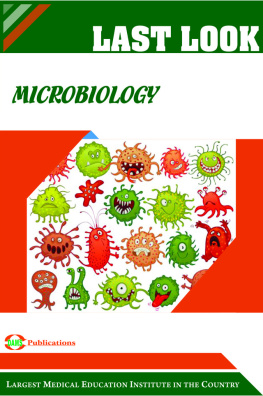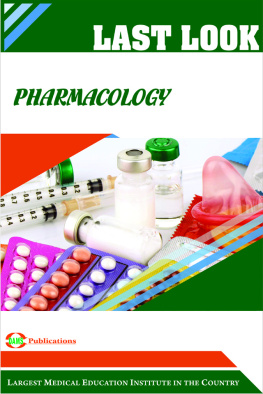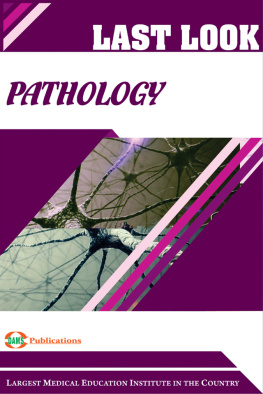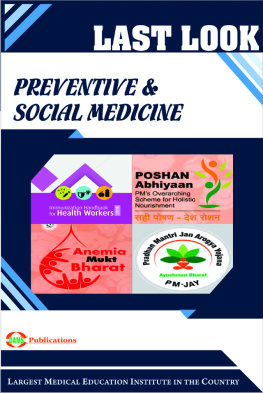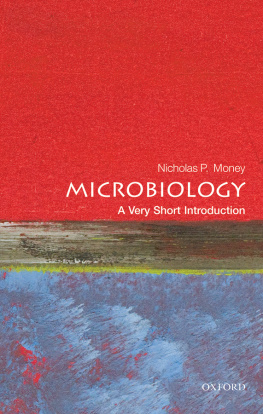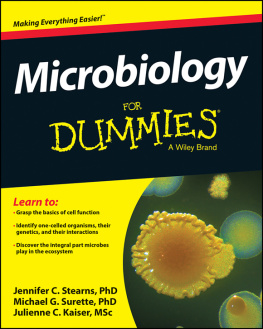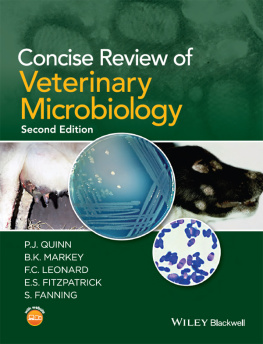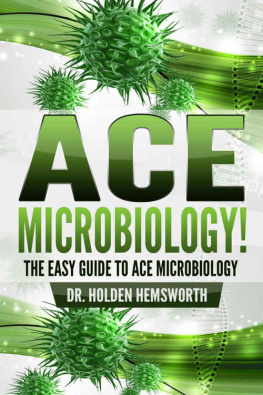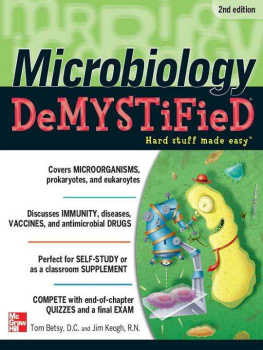LAST LOOK
Microbiology

LAST LOOK
Microbiology

Largest Medical Education Institute in the Country

Published by Delhi Academy of Medical Sciences (P) Ltd.
HEAD OFFICE
Delhi Academy of Medical Sciences (P.) Ltd.
4-B, Grovers Chamber, Pusa Road,
Near Karol Bagh Metro Station,
New Delhi-110 005 Phone : 011-4009 4009
http://www.damsdelhi.com Email: info@damsdelhi.com
ISBN :
First Published 1999, Delhi Academy of Medical Sciences 2018 DAMS Publication
All rights reserved. No part of this book may be reproduced or transmitted in any form or by any means, electronic, mechanical, including photocopying, recording, or any information storage and retrieval system without permission, in writing, from the author and the publishers.
This book contains information obtained from authentic and highly regarded sources. Reprinted material is quoted with permission. Reasonable efforts have been made to publish reliable data and information, but the authors and the publishers cannot assume responsibility for the validity of all materials. Neither the authors nor the publishers, nor anyone else associated with this publication, shall be liable for any loss, damage or liability directly or indirectly caused or alleged to be caused by this book.
Neither this book nor any part may be reproduced or transmitted in any form or by any means, electronic or mechanical, including photocopying, microfilming and recording, or by any information storage or retrieval system, without permission in writing from Delhi Academy of Medical Sciences. The consent of Delhi Academy of Medical Sciences does not extend to copying for general distribution, for promotion, for creating new works, or for resale. Specific permission must be obtained in writing from Delhi Academy of Medical Sciences for such copying.
Trademark notice: Product or corporate names may be trademarks or registered trademarks, and are used only for identification and explanation, without intent to infringe.
Typeset by Delhi Academy of Medical Sciences Pvt. Ltd., New Delhi (India).
The agents of human infectious diseases are bacteria, fungi (yeasts and molds), protozoa, helminths (worms), and viruses. Bacterial cells have a prokaryotic nucleus, whereas human, fungal, protozoan, and helminth cells have a eukaryotic nucleus. Viruses are not cells and do not have a nucleus.
All cells contain both DNA and RNA, whereas viruses contain either DNA or RNA, but not both.
Bacterial and fungal cells are surrounded by a rigid cell wall, whereas human, protozoan, and helminth cells have a flexible cell membrane.
The bacterial cell wall contains peptidoglycan, whereas the fungal cell wall contains chitin.
Comparison of Conjugation, Transduction, and Transformation
Transfer Procedure | Process | Type of Cells Involved | Nature of DNA Transferred |
Conjugation | DNA transferred from one bacterium to another | Prokaryotic | Chromosomal or plasmid |
Transduction | DNA transferred by a virus from one cell to another | Prokaryotic | Any gene in generalized transduction; only certain genes in specialized transduction |
Transformation | Purified DNA taken up by a cell | Prokaryotic or eukaryotic (e.g. human) | Any DNA |
Members of the Normal Flora | Anatomic Location |
Bacteroides species | Colon, throat, vagina |
Candida albicans | Mouth, colon, vagina |
Clostridium species | Colon |
Corynebacterium species (diphtheroids) | Nasopharynx, skin, vagina |
Enterococcus faecalis | Colon |
Escherichia coli and other coliforms | Colon, vagina, outer urethra |
Gardnerella vaginalis | Vagina |
Haemophilus species | Nasopharynx, conjunctiva |
Lactobacillus species | Mouth, colon, vagina |
Neisseria species | Mouth, nasopharynx |
Propionibacterium acnes | Skin |
Pseudomonas aeruginosa | Colon, skin |
Staphylococcus aureus | Nose, skin |
Staphylococcus epidermidis | Skin, nose, mouth, vagina, urethra |
Viridans streptococci | Mouth, nasopharynx |
Bacterial diseases transmitted by insects:
Bacterium | Insect | Reservoir | Disease |
Gram negative rods |
Yersinia pestis | Rat fleas | Rodents (e.g. rats and prairie dogs) | Plague |
Francisella tularensis | Ticks (Dermacentor) | Many animals (e.g. rabbits) | Tularemia |
Spirochaetes |
Borrelia burgdorferi | Ticks (brodes) | Mice | Lyme disease |
Borrelia recurrentis | Lice | Humans | Relapsing fever |
Rickettsiae |
Rickettsia rickettsii | Ticks (Demacentor) | Dogs, rodents, and ticks (Dermacentor) | Rocky Mountain spotted fever |
Rickettsia prowazekii | Lice | Humans | Epidemic typhus |
Ehrlichia chaffeensis | Ticks (Dermacentor, brodes) | Dogs | Ehrilichiosis |
Virulence Factors:
Organism | Virulence factors | Used in Vaccine | Comments |
Gram-positive cocci |
Streptococcus pneumoniae | Polysaccharide capsule | Yes | Determines serotype |
Streptococcus pyogenes | M protein | No | Determines serotype1 |
Streptococcus aureus | Protein A | No | Binds to Fc region of IgG, which prevents activation of complement |
Gram-negative cocci |
Neisseria meningitidis | Polysaccharide capsule | Yes | Determines serotype |
Next page
